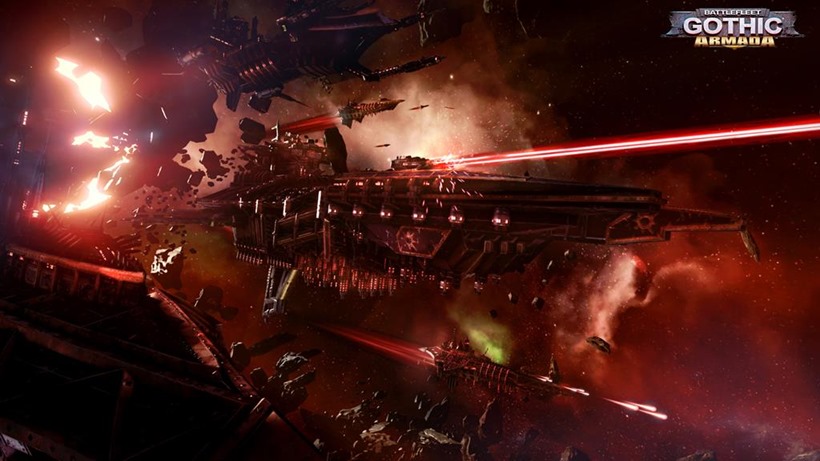
For ten thousand years, the Imperium of Man has endured under the rule of the Immortal Emperor. The worlds of Man are scattered across the galaxy, threatened by savage aliens, heretics who defy the Emperor’s will, and horrors lurking upon forgotten worlds. Prepare yourself for spaceship battles in the 41st Millenium!
Battlefleet Gothic: Armada from Tindalos Interactive is a digital adaption of Games Workshop’s all but abandoned tabletop space naval combat game, Battlefleet Gothic. Imagine naval combat in space, but with Orks, Elves, and space ships that serve as giant cathedrals. Demon possessed barges and giant trash heaps with LOADS of guns.
That’s Battlefleet Gothic.
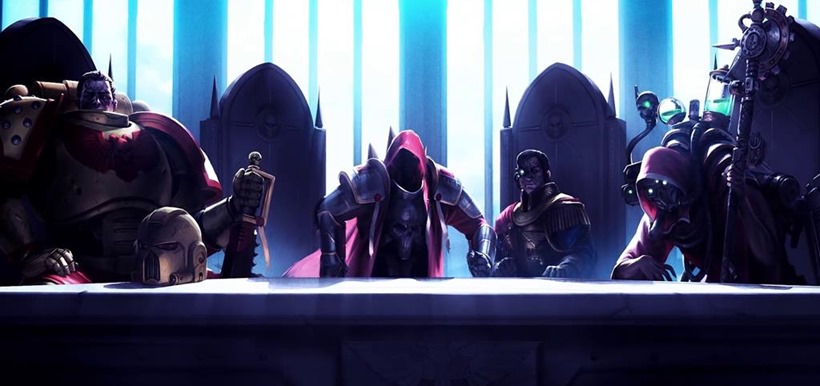
The game’s story focuses on the 12th Black Crusade, let loose upon the worlds of the Gothic system within the galactic Empire of Man, led by Abbadon, Warmaster of Chaos. As a captain within the Imperial Navy who happens to be on a mission to investigate a space station that has gone silent, you stumble upon the initial onslaught of a massive encroaching Chaos fleet.
Barely managing to escape to Port Maw, you inform the powers that be of the impending threat, resulting in you being chosen to lead a small battle-fleet to hamper, sabotage and protect the Gothic sector from Abadon’s invasion, while also fending off those rebelling against the Empire such as Ork pirates and Eldar saboteurs.
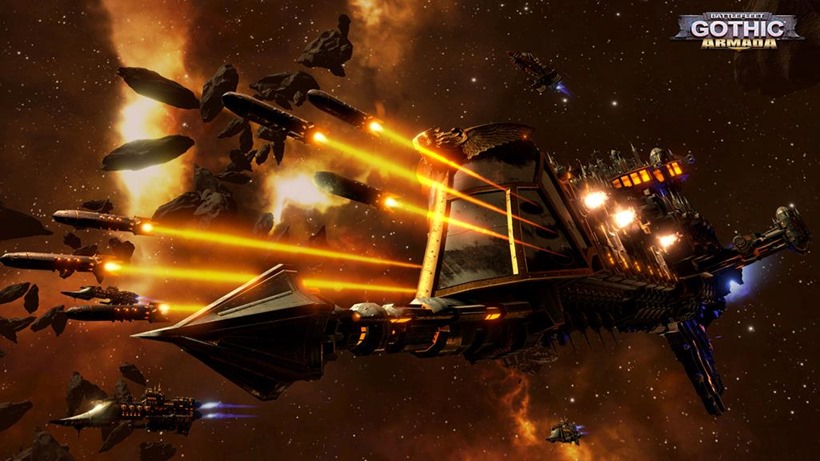
The campaign map consists of several regions, each with a collection of star systems that need to be defended should they be attacked. Many systems affect integral parts of your ongoing efforts, such as the cost of repairs, how much experience you gain and so on. Should you lose these worlds, your effort to maintain a defensive momentum will falter and become an increasingly daunting task. Failing narrative missions results in the story taking slightly different paths, with your enemies gaining bonuses along the way.
You’ll be notified when one or more systems are under threat, and after completing various priority missions you’re free to choose which systems to assist. However, you have a limited amount of deployments each turn as more and more systems are invaded. Quite quickly you’ll have to learn to leave systems under enemy control as you prioritise which ones to save instead.
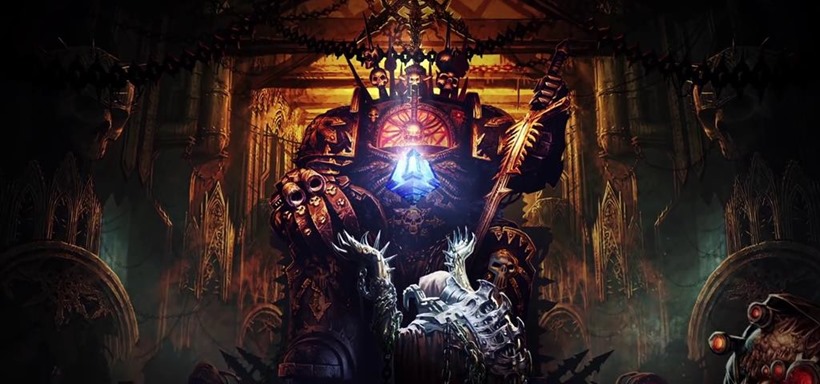
Most missions in the campaign, barring those few narratively crucial missions tweaked to be unique, are the exact mission types one will encounter in multiplayer. You’re essentially playing a normal skirmish game against the AI, so don’t expect a completely unique mission structure throughout the campaign. Battlefleet Gothic Armada is definitely a multiplayer game first, and campaign game second. The single-player content is mostly competent and fun, though a bit buggy at times.
It seems that injecting narratively unique twists into some missions can make them a bit wonky. Having played through the tutorial three times now has resulted in my ship being destroyed twice while I’m told that I’m victorious as I watch the burning wreckage float into space. There are also some odd quirks: being told that enemies can’t disengage for plot reasons, only to win a mission when they do just that.

I’ve enjoyed playing through the campaign, though the difficulty can spike surprisingly and unexpectedly, especially during narrative missions where the result can empower whichever side wins. The great effort to make Battlefleet Gothic Armada faithful to the franchise is an immense help, and the acting is all on point and fantastic across all factions.
I’ve a soft spot for the Orks, and I adore how they sound and respond here.
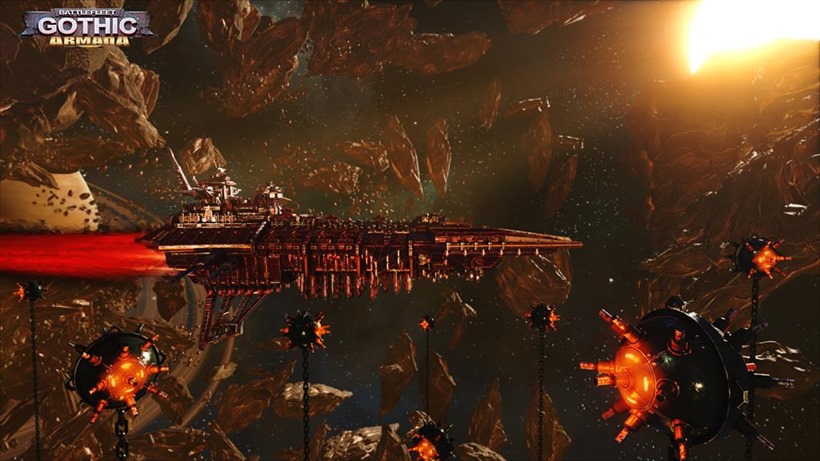
Multiplayer is the game’s strong point. As you play, you’ll be limited to which ships you can field, and how large the games you can play. As you play more games you’ll earn Renown, which is what counts as experience for your profile and your ships and can also be spent on upgrades, buying new ships, or repairing what you’ve got. Importantly, you can still earn Renown even if you lose, but you’ll earn more if you win and for each enemy ship you destroy or leave crippled.
Losing a ship, having it heavily damaged or even having it warp out during a mission has a chance of temporarily making that ship unavailable for a turn or two while it recovers.
As your profile levels up, you’ll gain access to larger point games, new ship slots for larger vessels and more slots for you to expand your fleet with. Each profile is faction locked however, so while you may have a high level Chaos profile you’ll also need to make a profile for each of the other factions and work your way up the ladder individually. Matchmaking matches you with players of a similar level, so it helps when trying a new faction and you’re not getting thrown against expert players.
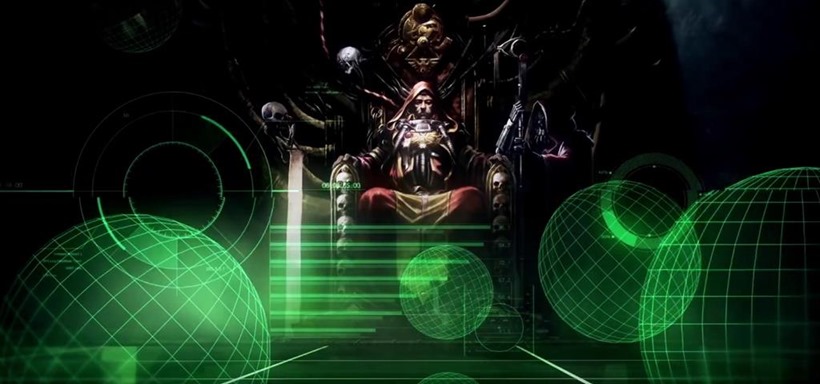
Speaking of factions, at launch Battlefleet Gothic Armada has four sides available: The Imperial Navy, the Chaos fleets, Ork Pirates and Eldar Corsairs.
The Imperial Navy ships are pondering bruisers, preferring to get in close and let loose a devastating fusillade broadside. Their ships are heavily armoured and are more willing to actively ram their way through enemy fleets thanks to their prow shields. While their standard armoury of cannons can suffer at range, they also have easy access to the Nova Cannon – a very powerful weapon with ridiculously long range (though it’s not always guaranteed the shot will land exactly where you want) and plentiful access to torpedoes, both of which allow them some ability to fight over a longer distance.
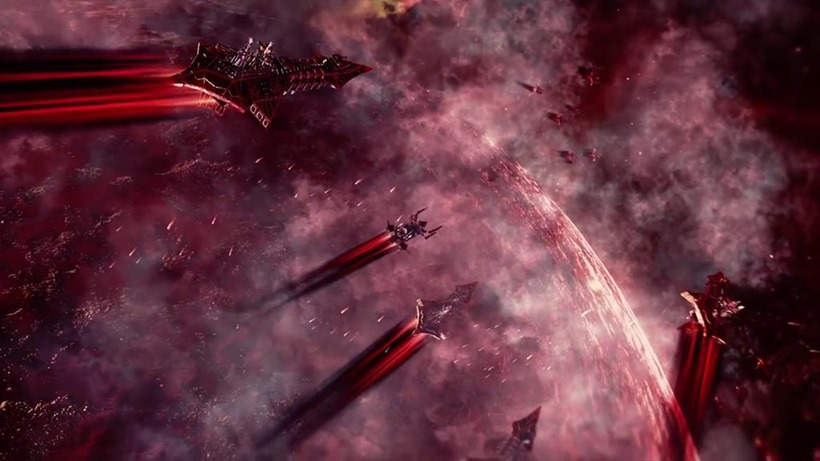
The Navy also has access to Full Ahead movement, which allows for a controlled forward boost, and Hard Turns, which allow the ship to perform quick turns on the spot which is essential for keeping targets in broadside arc, shifting the ship so that it can fire torpedoes where you need them in a pinch, or simply drastically redirecting the ship’s course. Overall, the Imperial Navy is the most adaptable fleet, though it can find it difficult to excel as well as other fleets in specific situations.
Chaos ships aren’t as tanky as the Imperial Navy or the Ork fleet and instead rely on long-range harassment and speed. Favouring far-ranged and accurate lance weaponry as opposed to the brutish shorter ranged cannon weaponry of the Imperials and fighter support, Chaos ships prefer to keep out of the effective range of enemy fire and retaliate from afar before coming in close to finish crippled targets.
Sharing the Full Ahead and Sharp Turn manoeuvres of the Imperial Navy, the Chaos fleet is adept at using their greater speed to disengage from closer ranged battles where their relative fragility breaks them and force their opponents to fly inwards to catch them while they reposition and continue to lay down a broadside assault.
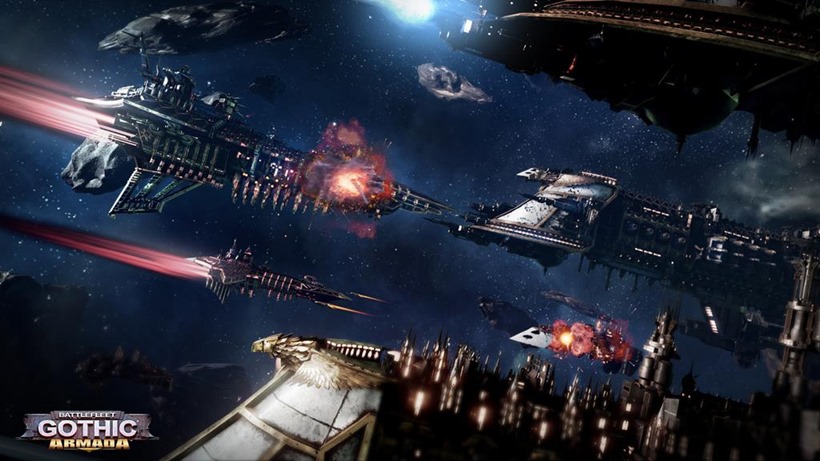
The Orks boast the sturdiest and most well armoured ships out of all four factions, are particularly good at boarding and have a LOAD of guns on their ships. They suffer for these perks with poor weapon accuracy, sluggish ships and an inability to flee from battles. The Orks’ general offensive strategy largely focuses on ramming enemy ships, taking less damage than what they deal out as they roar and laugh their way through the carnage.
To this end, Orks have the Big Red Button which allows for a short but significant speed boost best used to rush and ram ships, a wonderful giant blaring fog horn and blasting exhaust fumes included. One of the greatest joys in the game is managing to ram your larger Ork ships through enemy frigates, as games where Ork on Ork battles devolve into a hilarious Greenskin Space Monster Truck Rally.
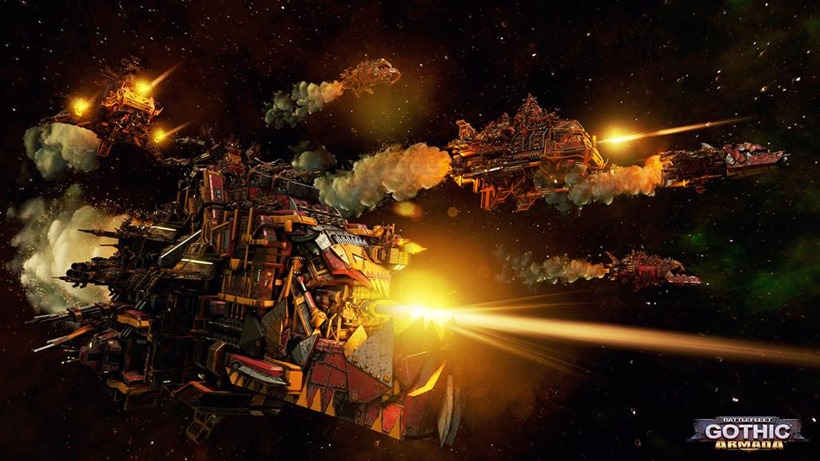
Orks also have access to unique weaponry such as a choice of torpedoes that, instead of explosives, contain more Orks which results in a boarding action rather than payload detonation when they hit. There’s the Traktor Beam which can be used to yank a target ship in any direction you wish, deadly long range Zzap Kannons which have a chance to explode when fired and even their own Nova Kannon which has even bigger chance to detonate once triggered.
And then we have the Eldar, the trickiest of the factions. The Eldar have the fastest ships, some of the most powerful guns, accuracy and the best range in the game. The payoff is that the majority of their weapons only fire out of their front arcs, while their ships are shockingly fragile. Instead of the standard shields used by the other factions, the Eldar rely on Holo Shields that reduce the damage they take and are more effective the faster they fly.
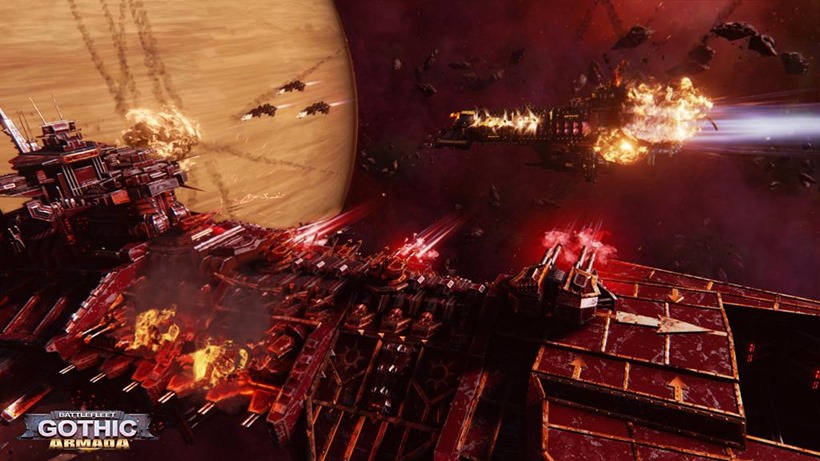
The complicated part of the equation comes in when one realizes that in order for an Eldar player to fire at their targets, they will need to face their targets head on due to the dominance of their prow-mounted weaponry, a tactic that isn’t easy to achieve when one also wants to keep moving so that the Holo Shields stay at full power.
As such, the ideal attack approach is to strike the enemy on approach and disengage while another of your ships do the same. The constant need to remain mobile and re-orientate for forward firepower means that the Eldar can be difficult to fly, but are tremendously rewarding for anyone who takes the time to master them.
Getting back to multiplayer, there’s a variety of mission modes, including missions where the player needs to destroy the opposing player’s Admiral ship before it can escape, stealing data from another ship and escaping with it before the defending player can do the same. There are also defense missions where one player must protect a space station or defense emplacements from the opposition or needs to protect a convoy of transports.
And of course, there’s also the classic death match option.
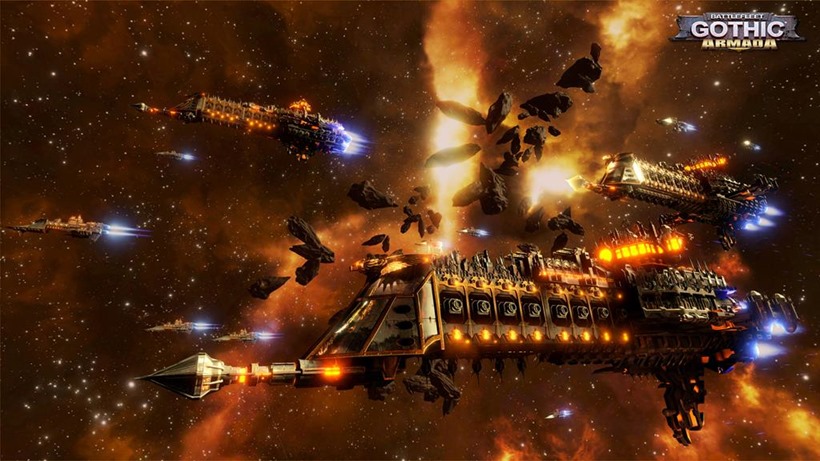
Before a game starts both players are able to select ships for their army, knowing the mission and their role in it. Both players have the same amount of points they can spend to select ships, while different ships cost more or less points depending on how powerful they are. When the match starts, there’s an initial deploy period where both players choose where to place their flotilla. Most game modes, outside of ones that involve defending specific craft, structures or transports have players placing their ships on opposite sides of the map. Once both players are ready, the game starts in earnest.
Initially, all you’ll see of your opponent’s ships are blips on the radar and red blips on the battle field – it’s only while they’re within sensor or probe range that you’ll see exactly which vessels are which. An exception to this is mission critical ships, which are often revealed early on so you know which cruiser to focus on and to prevent your opponent from hiding said space-cathedral indefinitely.
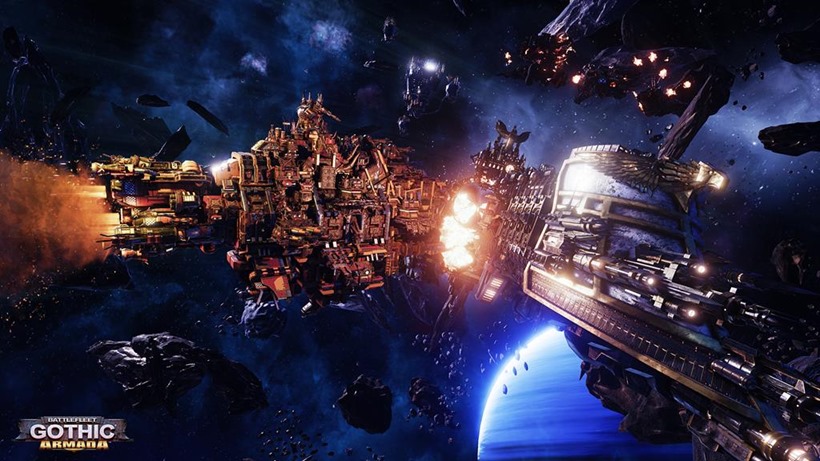
How you choose to approach your opponent is critical and it’s why choosing probe upgrades rather than offensive, defensive, or supportive upgrades can be important. In combat each ship is a complex beast. All vessels across all the factions have access to four basic Command actions:
- Reload – Reduces the cool down on ordnance and volleys of fire
- Lock on Target – Increases accuracy and critical hit chance of all weapons
- Brace for Impact – Reduces the amount taken from damage
- Run Silent – Which when not in sensor range of a ship or probe, effectively cloaks the ship and makes it invisible both in the field of battle and on the mini-map.
Using any one of the commands puts ALL command actions on a long cool down, so which one you choose to use and when you use it is important. In addition, all ships also have access to the Repair order, which will repair hull damage for a limited period of time although the cooldown is quite severe.
All non-escort ships also have two boarding action orders, and like Command orders, using either puts both on cool down.

Lightning Strike has a much larger range and can be used to sabotage specific ship systems or cancel abilities, most notably preventing a vessel from warping out of combat but requires the target shields to be down. Boarding Actions have a much shorter range, and can only target vessels out of the side arcs but do not require shields to be down and can potentially deal more damage over time when compared to Lightning Strikes.
Finally, non-escort ships have abilities granted by weapon or ability upgrades. Being able to efficiently keep track of all your ships and which abilities they are using are crucial in handling a combat situation.
Special mention must be given to ramming in Battlefleet Gothic Armada.It looks and feels fantastic, conveys an amazing sense of momentum and physicality to the hulking starships. It’s a fantastic feeling when two flagships connect, like a giant space punch with metal creaking and groaning as the ship materials are redirected and grind against each other from the force of the impact.
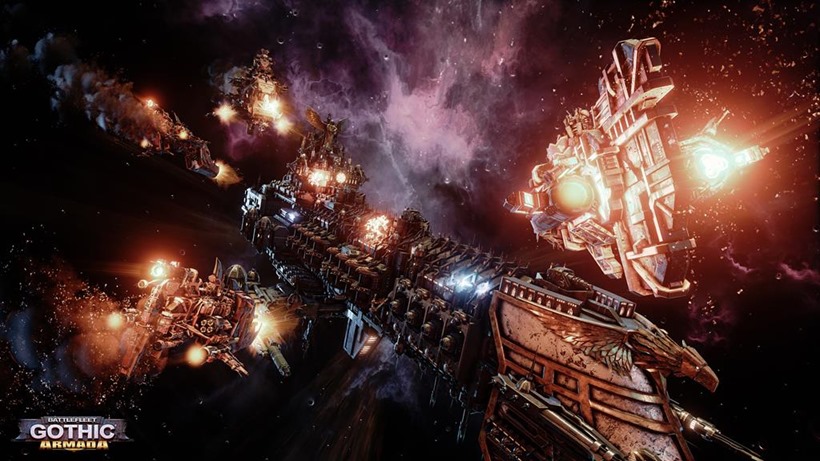
The micromanagement play needed at higher point games where one is playing with quite a few ships can be daunting, as you’ll be continuously managing how your ships fly and fight. Micromanagement is needed simply to keep ships moving and using abilities in ways that best suit you. The timing and placement of abilities, how you navigate around obstacles or incoming mines and how you move to intercept enemy targets all need constant attention.
Ships left by themselves will, unless given an order to engage targets freely, sit idle if their target is destroyed or has hidden itself which can easily be frustrating to find you’ve been too busy heavily micro-managing other vessels in your navy to be able to pay attention. Additionally, ships you command will move without heeding obstacles such as asteroid fields or mines, and require manual redirection to avoid. While upsetting, it’s not exactly a problem – how players best manage their ships is a big part of playing the game.
Legitimate problems are there however. While it’s useful at times for ships to automatically start turning to avoid enemy ships when collision is close, it’s frustrating when a collision is your intention, especially when it comes to playing Orks where that happens to be a central combat strategy. I also disliked how the camera orientation works at match start, though it’s possible this may simply be a matter of preference. The camera often positions itself to give you the perception of deploying at the bottom of a map, whereas the mini-map is fixed and on it you’re at the top.
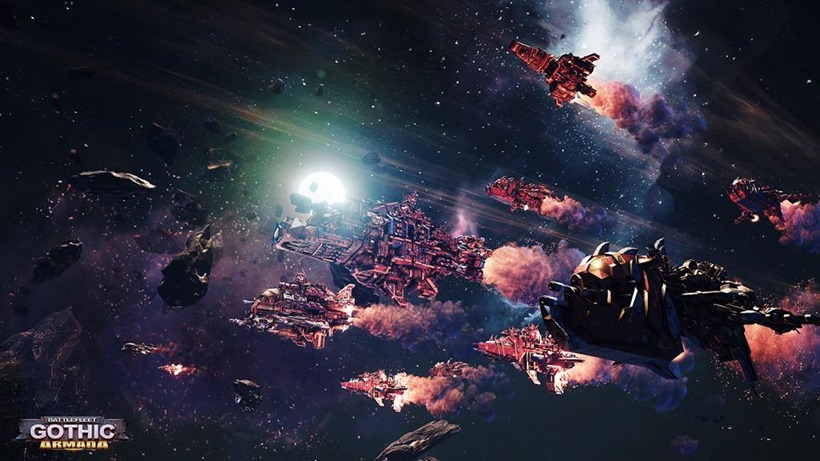
While the camera can be easily rotated to be more accurate, there have been times (particularly during the campaign) where I’ve deployed incorrectly due to assuming the game camera was angled to show the same orientation as the minimap.
Last Updated: April 21, 2016
| Battlefleet Gothic Armada | |
|
Slight frustrations aside, I’ve really enjoyed Battlefleet Gothic: Armada. It’s a fantastic micromanagement heavy “naval” skirmish game that drips with the Warhammer 40k flavor. It’s always great to see a genuinely good Warhammer game, particularly a 40k one, that’s not something of a throwaway these days.
|
|
|---|---|
| Battlefleet Gothic Armada was reviewed on PC | |
|
77 /
100
| |






















Emprah
April 22, 2016 at 07:26
Good one, I agree on all things, except the nova cannon is rather weak, and orks are now prone to flee from battle if the tide turns against them.
Also, zapps no longer blow themselves up.
For the Emperor!
April 22, 2016 at 09:03
Have not player MP yet (even during Beta where I had connection issues), and only just started the Campaign since the game only fully released last night, but played many Skirmishes during the Beta that were fun. Can’t play with the Orks and aiming the Imperial Torpedo Ships needs more practice, but loving the “vibe” in the game!
chimera_85
April 22, 2016 at 12:59
Can’t wait to play this